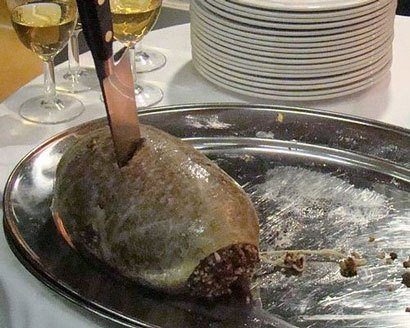Happy Burns Night!
Tonight marks Burns Night, an evening of poetry, whisky, and eating of one of the most frightening and misunderstood foods known to man: haggis. In Scotland it's as popular as any holiday, but in the United States it's often a source of confusion, and in some cases (especially after you learn what's in haggis), fear. So here's a little primer on the man who lends the evening its name, and just what you might be expecting to eat should you find yourself at the traditional feast.
First of all, Burns Night gets its name from famed Scottish poet Robert Burns (1759-1796), perhaps best known for his works including "Tam O'Shanter" and the lyrics to "Auld Lang Syne." He wrote in the Scots language, so if you were to find yourself at a Burns Supper you'd most likely not understand much of what was spoken. But that's just fine.
Burns Suppers follow strict rituals, beginning with the saying of the Selkirk Grace. After that, the main event comes emerges from the kitchen, oftentimes accompanied by a bagpiper: the haggis. Haggis is one of those "don't ask what's in it" kinds of foods, but since you asked: it's the heart, liver, and lungs of a sheep, ground up and mixed with onion, oatmeal, suet, stock, and spices, stuffed into the sheep's stomach (more likely to just be sausage casing these days), then simmered in water for three hours. You shouldn't have asked.
Once the guest of honor is placed (plopped?) onto the table (to the "oohs" and "aahs" of the crowd, we're sure), the host then stands before the haggis and addresses it. Not with just any old speech honoring sheep innards, mind you: a full-length poem called "Address to a Haggis," written by none other than Robert Burns himself. Here's the first stanza:
"Fair fa' your honest, sonsie face,
Great chieftain o' the puddin'-race!
Aboon them a' ye tak yer place,
Painch, tripe, or thairm:
Weel are ye wordy o' a grace
As lang's my airm."
As you might have figured out by now, Burns Night is not for amateurs (and hopefully at least one guest is fluent in Scots). After the entire poem is read, the haggis is cut open, a glass of Scotch whisky is raised in its honor, and guests line up to serve themselves a spoonful of the savory goodness. It's served alongside tatties and neeps, which sounds intriguing but is in fact just mashed potatoes and mashed turnips. One good thing about Burns Supper: you don't need teeth to enjoy it.
Other traditional accompaniments include cranachan (a raspberry trifle soaked in whisky), oatcakes, and cheese, and it's all washed down with even more whisky.
After the meal, more toasts are given, more poetry is read, more whisky is consumed, and at the end of the night the guests actually do something that's quite common in America: they drunkenly sing "Auld Lang Syne."
So in conclusion, Burns Night celebrates one of Scotland's greatest poets by toasting to haggis, eating and drinking a lot, and celebrating the company of good friends and shared tradition. If you're ever in Scotland and find yourself at a Burns Supper, be a good sport and try the haggis. We hear it actually tastes pretty good.
Dan Myers is the Eat/Dine Editor at The Daily Meal. Follow him on Twitter @sirmyers.
